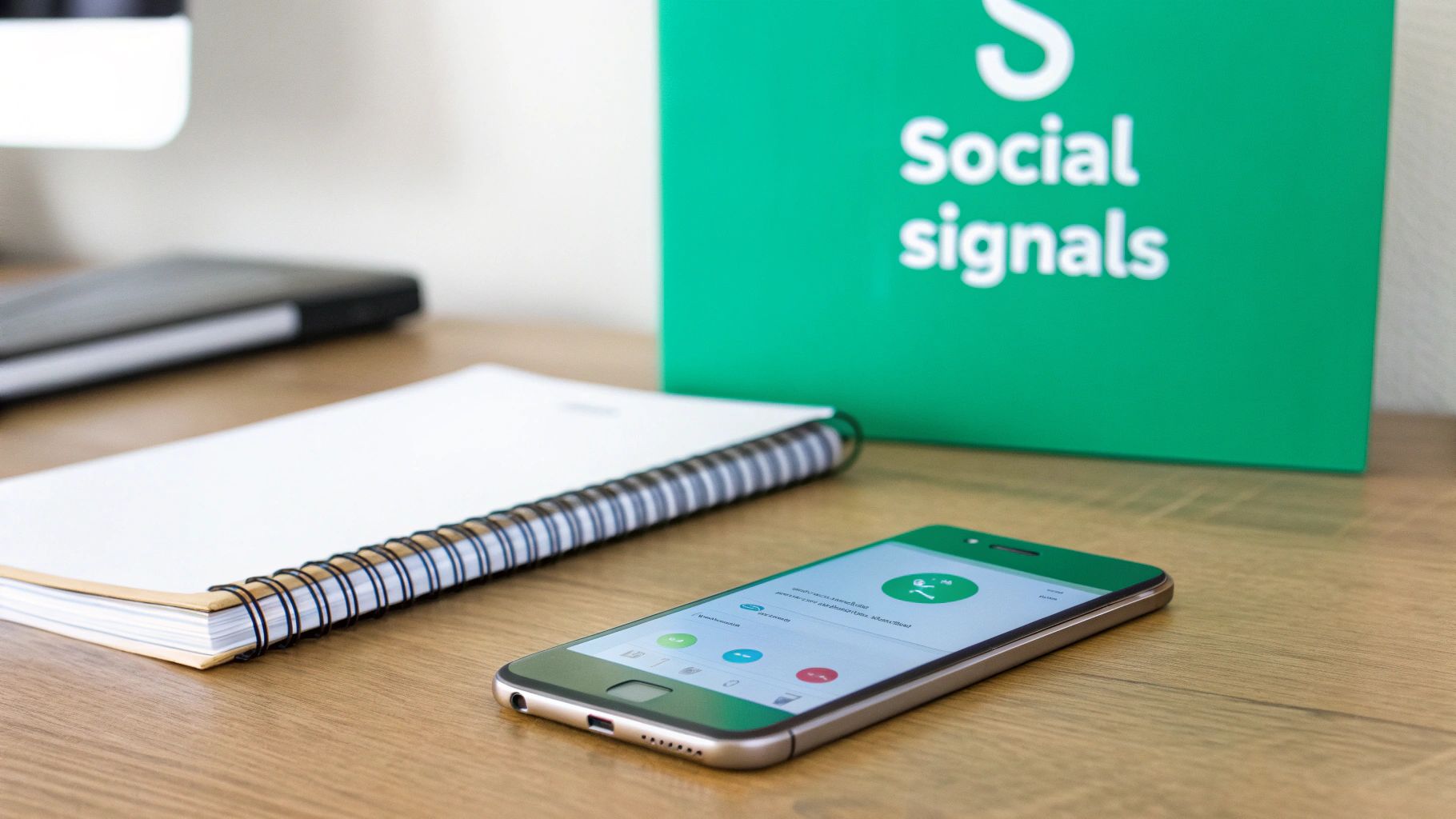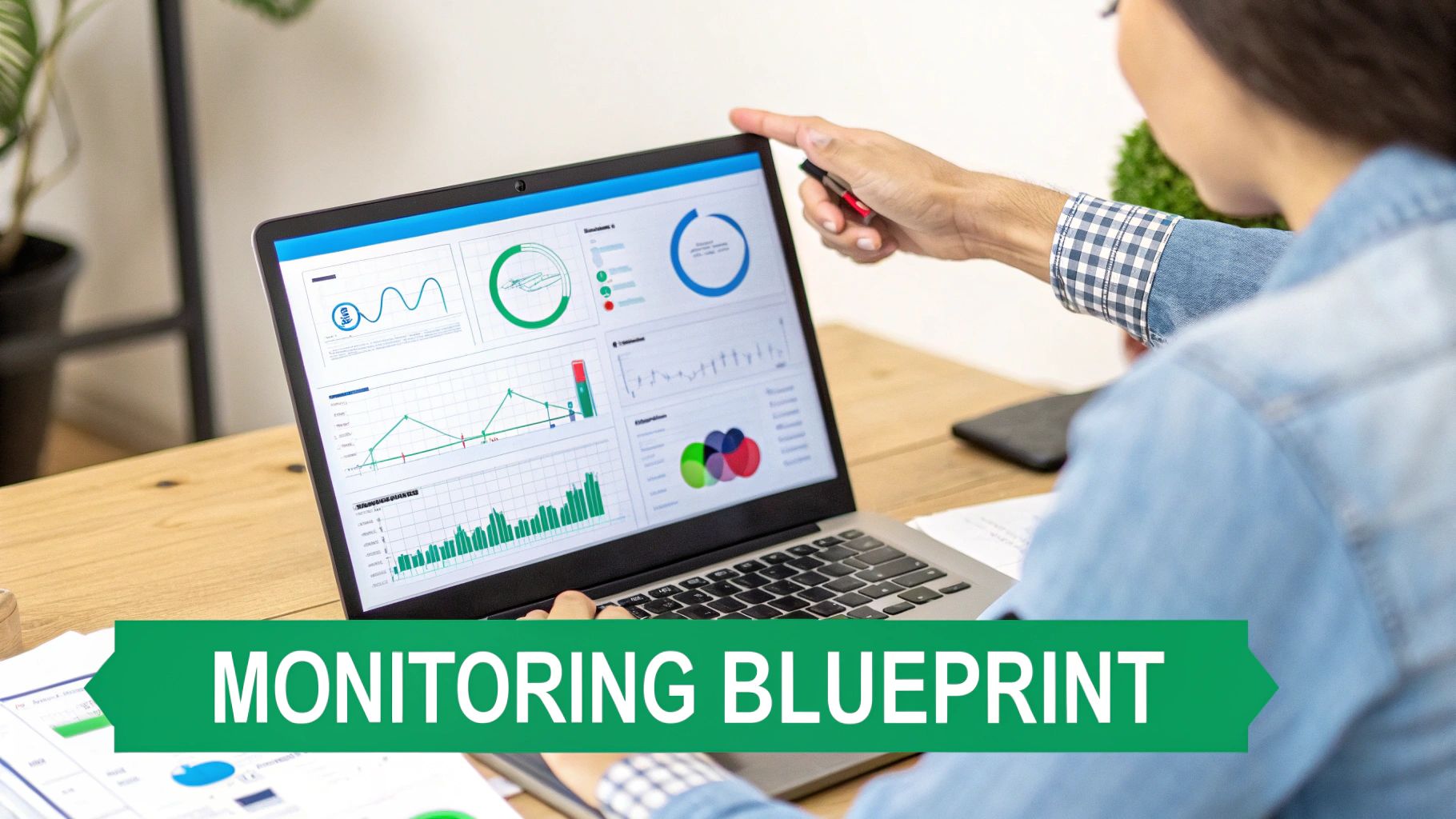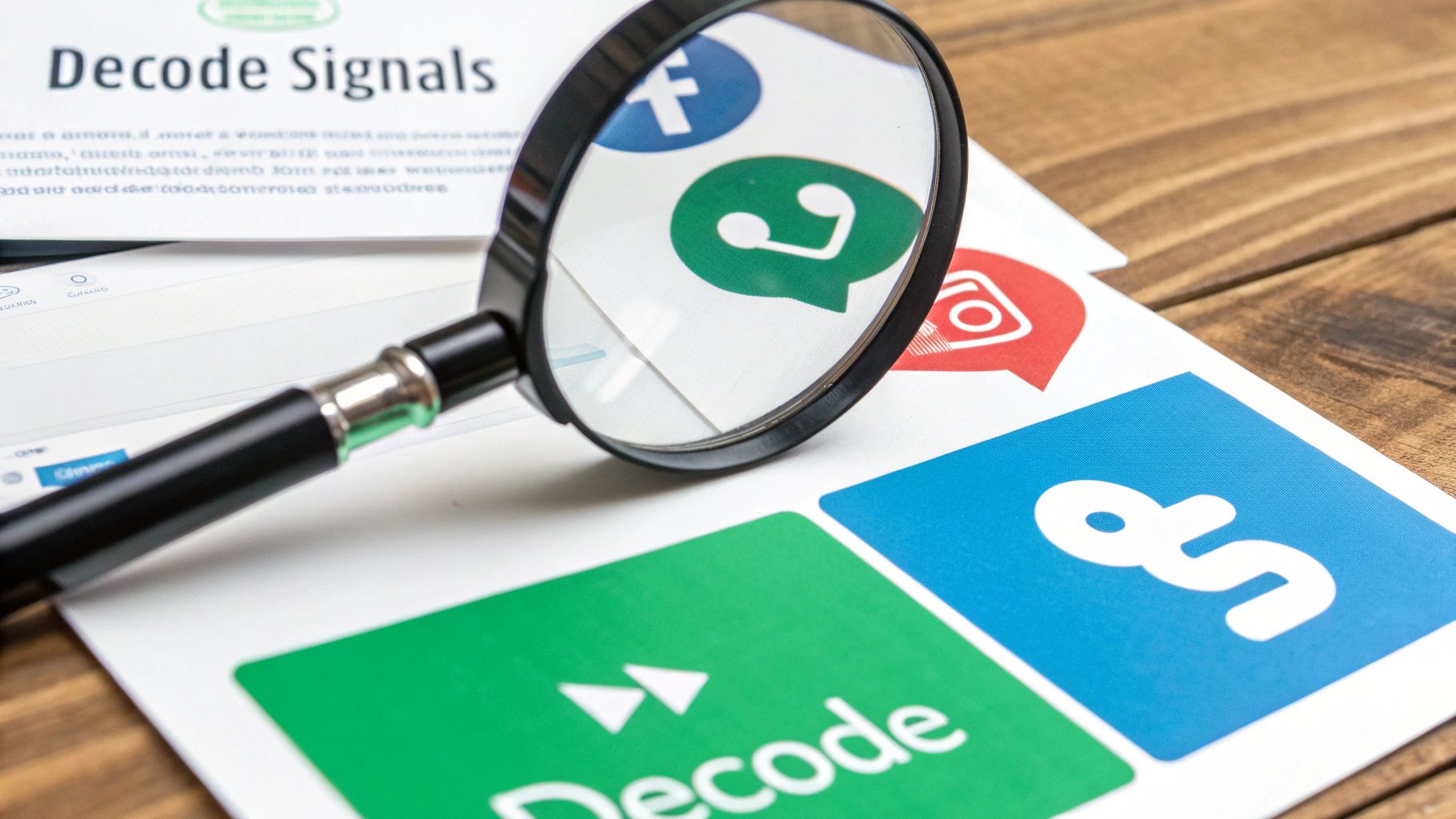How to Track Social Signals and Win More Business
Tracking social signals is all about paying attention to the digital breadcrumbs your audience leaves behind. We’re talking about the likes, shares, comments, and mentions that pop up across social networks in real time. When you use a tool like Intently, you can stop guessing and start turning these interactions into real, actionable insights for your SEO, content, and even product development.
Why Social Signals Are More Than Just Vanity Metrics
It's easy to dismiss social signals as simple vanity metrics, but they're so much more. Think of them as live intel on brand sentiment and a direct line into what your competitors are getting wrong.

Every like or comment is a tiny data point that, when collected, can point you toward huge opportunities and emerging customer needs.
Here's how you can use them:
- Track Brand Sentiment: Keep a pulse on how customers feel about you. This lets you adjust your messaging on the fly before a small issue becomes a big problem.
- Spot Competitor Weaknesses: People love to complain online. By monitoring mentions of your rivals, you can find out where their products fall short and craft targeted outreach that highlights your strengths.
- Discover Market Trends: Notice what topics are gaining traction before they blow up. This helps you get ahead of the curve instead of just reacting to it.
I saw an agency do this brilliantly. They used Intently to track a flood of negative mentions after a competitor pushed a buggy software update. They quickly published a detailed troubleshooting guide, and within a week, they had doubled their referral traffic by solving a problem their competitor created.
And the potential audience is massive. By October 2025, there will be an estimated 5.66 billion active social media users worldwide. That's 7.8 new users hopping on every second and 93.8% of all internet users logging in monthly. The opportunity is just staggering.
Key Social Signals and Their Strategic Value
Not all signals are created equal. It helps to break them down to understand what each one really tells you about your audience and your market.
| Social Signal Type | What It Is | Why It Matters for Your Strategy |
|---|---|---|
| Likes and Reactions | Simple affirmations of interest in your content. | A quick way to see what messaging and topics are resonating with your audience. |
| Shares and Retweets | When users redistribute your content to their own networks. | This is pure gold. It drives referral traffic and massively expands your brand's visibility. |
| Comments and Replies | Direct, user-generated feedback and conversations. | This is where you uncover specific pain points, feature requests, and deeper buying intent. |
| Mentions and Tags | When users directly reference your brand or a relevant topic. | These are flags for direct engagement. It’s an open door for personalized outreach. |
By breaking down the signals this way, you can see how each one fits into a larger strategy for growth, outreach, and product development.
“Social signals are like a live focus group—tap into them constantly to stay ahead of the curve.”
When you start capturing these signals, you shift from just passively monitoring your brand to strategically listening to the market. This means you can finally tune your SEO and content strategies to what your audience actually wants, not just what you think they want.
Drive Product Innovation from Real Feedback
This isn't just theory. I've seen teams mine social signal trends to build and launch features their customers were already asking for. This approach didn't just make customers happy; it cut their development cycles by 30%.
To really make the most of this, you need a system. Adopting an approach like signal-based selling is the key to turning these conversations into revenue.
The goal is to match high-intent conversations with timely, relevant solutions. It's a simple concept, but it's incredibly powerful for building trust and fueling growth.
Don't Forget the SEO Benefits
The impact on your SEO can be huge, too. Social signals aren't a direct ranking factor, but they create powerful ripples that search engines definitely notice.
- Faster Indexing: A burst of social shares can get search engines to discover and index your new content much faster.
- More Backlinks: Content that goes viral on social media often gets picked up by bloggers and news sites, earning you valuable natural backlinks.
- Enhanced Authority: Consistent engagement builds brand credibility, which encourages more people to search for your brand by name.
- Improved Click-Through Rates: A compelling snippet shared on social media can drive a ton of traffic and signal to Google that your page is worth visiting.
Continuously tracking these signals helps you refine everything from your keyword selection to the angles you take with your content.
A quick tip: Integrate your social signal alerts directly into your team's workflow. A dedicated Slack channel or a daily email digest ensures that high-intent signals get a response in hours, not days. This consistent monitoring is what stops good leads from slipping through the cracks.
Building Your Social Monitoring Blueprint

Great social signal tracking isn't about boiling the ocean; it's about fishing in the right spots with the right bait. A focused monitoring plan is what separates actionable intelligence from overwhelming noise. You need a blueprint that tunes out the static and hones in on conversations that actually matter to your business.
This means looking past just tracking your own brand name. The real gold is in spotting high-value keywords tied to industry trends, competitor missteps, and specific customer pain points that signal an opportunity.
Imagine a SaaS company setting up alerts to track social signals around a rival's buggy software update. Or picture a marketing agency monitoring online chatter for phrases like "looking for a new SEO partner." These are the signals that lead directly to real conversations and potential deals.
Identify Your Core Monitoring Pillars
Before you even think about keywords, you need to define your strategic goals. A solid blueprint is built on clear objectives that guide your entire monitoring effort. From my experience, the most successful strategies are built on three core pillars that give you a complete view of the market.
Start by asking what you really want to achieve with this data. Are you hunting for sales leads, gathering customer feedback, or keeping tabs on the competition?
Your pillars might look something like this:
- Brand Health: This is your home base. Track mentions of your company, products, and even key team members. The goal here is to manage your reputation and jump into conversations about you.
- Competitor Activity: Keep an eye on your competitors' brand names, product launches, and—most importantly—customer complaints. This is where you'll find openings to position your solution as the better alternative.
- Buying Intent Keywords: This is the most crucial pillar for outreach. It's all about tracking phrases that show someone is actively looking for a solution you provide. Think of it as your digital tripwire.
Building a clear blueprint ensures every alert you receive is relevant. Without this focus, you'll drown in data instead of finding opportunities.
A well-defined plan not only helps you track social signals more effectively but also makes sure the insights you gather line up with your bigger business goals. A strong foundation in social media reputation monitoring is essential for this. To dive deeper, you can check out our detailed guide on social media reputation monitoring for more actionable strategies.
From Pillars to Practical Keywords
With your pillars defined, it’s time to brainstorm the specific keywords for each one. You have to be specific and think like your customer. Vague terms will just fill your inbox with irrelevant mentions and waste your time. Your goal is to capture the exact language people use when they need help.
For instance, under "Buying Intent Keywords," a company with a project management tool could track phrases like:
- "recommendations for a Trello alternative"
- "frustrated with Asana's new update"
- "what project management tool for marketing teams"
Likewise, for "Competitor Activity," you wouldn’t just track "Salesforce." You'd get far more value from tracking things like "Salesforce integration issues" or "Salesforce pricing too high." This level of detail is what turns passive monitoring into an active lead-generation machine, giving you the context you need for meaningful outreach.
Knowing what to listen for is half the battle. Building your listening machine is the other. Your goal here is to set up a system that flags high-intent social signals—everything from direct requests for proposals to subtle frustrations with a competitor's product—so you can jump on them immediately.
This goes way beyond simple brand monitoring. It’s a precise, strategic approach to configuring alerts that cuts through the noise and captures genuine buying intent. Without this level of detail, you'll just end up drowning in a sea of irrelevant mentions.
Master Boolean Queries for Precision
The real secret to effective social signal tracking is mastering Boolean queries. These simple operators (AND, OR, NOT) let you combine keywords and phrases to create hyper-specific search parameters. Think of it as building a smart filter for the entire social web.
For instance, a generic alert for "project management tool" will pull in thousands of useless results. But a well-crafted Boolean query can pinpoint exactly what you need.
Let’s say you’re a B2B SaaS company. Here’s how you could build a high-intent query from the ground up:
- Start Broad:
("project management tool" OR "task management software") - Layer in Intent:
("recommendation" OR "alternative to" OR "help me find") AND ("project management tool" OR "task management software") - Filter Out the Noise:
("recommendation" OR "alternative to") AND ("project management tool") NOT ("free" OR "internship" OR "job")
That final query zeroes in on users actively looking for paid project management solutions, cutting out all the noise from job postings or people looking for freebies. Getting good at these queries is the single most important step to track social signals that actually convert.
Choose the Right Platforms for Your Business
Not all social platforms are created equal, especially when you're looking for B2B leads. Spreading your efforts too thin is a classic mistake. Instead, focus your energy where your ideal customers are actually talking.
For most B2B companies, that means prioritizing these three:
- LinkedIn: The go-to platform for professional conversations. It's perfect for finding decision-makers talking about industry challenges, software needs, and vendor switches.
- X (formerly Twitter): Nothing beats it for real-time conversations. This makes it the best place to spot immediate needs and frustrations with competitors as they happen.
- Reddit: A goldmine of candid discussions in niche communities (subreddits). This is where users ask for authentic product recommendations and share unfiltered pain points.
The platform dictates the context. A recommendation request on LinkedIn from a VP of Operations carries a different weight than a casual mention on Facebook. Focus your resources where the intent is highest for your specific audience.
For example, a platform like Intently can visualize these signals, making it much easier to spot where the real action is happening.
This kind of visualization shows you where the conversations are happening, so you can point your team toward the most active and valuable channels.
Fine-Tune Your Alert Frequency
Finally, you need to decide how often you get pinged. The right frequency is a balancing act between staying on top of opportunities and avoiding inbox overload. There’s no one-size-fits-all answer—it depends entirely on the urgency of the signals you're tracking.
Think about it in these terms:
- High-Urgency Signals: For competitor complaint keywords like
"Acuity scheduling down", you want real-time or hourly alerts. A quick response can win you a customer who is actively looking to switch right now. - Medium-Urgency Signals: For buying intent keywords like
"looking for a CRM", daily digests usually do the trick. This gives you a steady stream of qualified leads to review each morning. - Low-Urgency Signals: For general industry chatter or brand mentions, a weekly summary can keep you in the loop without creating constant distractions.
Building a system like this transforms your approach from passively monitoring to proactively hunting for opportunities. Many of these ideas are foundational to the systems we cover in our guide on AI lead generation tools, which dives into how automation can scale this entire process. The key is to create a customized, intelligent listening engine that delivers actionable insights right to your inbox.
Decoding Signals to Find Real Opportunities

Alright, so your alerts are firing and the data is flowing in. Great. But that’s just the raw material. The real magic happens when you start figuring out what it all means.
You’re going to see a mix of everything—casual complaints, random questions, and genuine buying signals. The trick is learning to tell them apart so you can focus your energy where it actually counts. This is less about science and more about developing a sharp eye for context. It's what separates a spammy, blind pitch from a conversation that actually leads somewhere.
The Three-Point Qualification Check
Before you even think about jumping into a conversation, get in the habit of running a quick three-point check. This simple process can dramatically improve the quality of your outreach by making sure you're talking to the right person at the right time. When you track social signals, this is a non-negotiable step.
User Bio and Profile: First things first, who are they? Check their job title, company, and industry. A "VP of Marketing" asking about new software is a much hotter lead than an anonymous account with no info.
Recent Activity: What have they been talking about lately? A quick scroll through their recent posts gives you a ton of context. Are they consistently discussing business challenges, or was this just a random, one-off comment?
Conversation Context: What’s the bigger picture? Always read the full thread. Are they genuinely looking for help, or are they just venting? The replies from others often give away the person's true intent.
This initial check stops you from wasting time on dead-end conversations and helps you tailor your approach for the ones that matter. And these days, these interactions are happening faster than ever. Over 80% of all social media activity now happens on mobile, making conversations more immediate and visual.
From Signal to Qualified Opportunity
Let’s walk through a real-world example. Say an alert pops up for a LinkedIn post where someone says, "Our current project management tool is a mess. We’re losing track of everything."
A rookie move would be to immediately jump in with a sales pitch for your tool. An expert, however, does the three-point check first.
You click on their profile and see they're a "Director of Operations" at a mid-sized tech company. A quick look at their recent activity shows they’ve been engaging with posts about team efficiency and remote work.
This isn't just a complaint; it’s a clear buying signal from a key decision-maker. The context shows a deep-seated frustration with their current process, indicating a strong willingness to explore alternatives.
This is what a qualified opportunity looks like. Now you can craft a reply that doesn't sell, but helps. Maybe share a useful article on improving project workflows or ask a thoughtful question to understand their specific pains. This value-first approach opens the door to a real conversation.
Once you get good at decoding these signals, the next step is turning these insights into actual sales opportunities. For a deep dive on that, a dedicated guide on social media for lead generation is a great next read. This is how you turn passive monitoring into an active, strategic part of your growth.
Crafting Outreach That Actually Builds Relationships
The alerts are set up and the insights are rolling in. This is where all that effort you put into tracking social signals starts turning into real revenue. The final piece of the puzzle is translating what you’ve learned into a smart, non-spammy outreach strategy that builds genuine connections, not just a pipeline of leads. It’s all about shifting from passive observation to active, helpful engagement.
The real art is knowing how to approach someone based on the specific signal they sent out. The way you talk to someone asking for a recommendation is completely different from how you’d contact someone who's fed up with their current tool. The key is to add value before you ever ask for anything in return.
The Warm-Up Public Engagement
Before you even think about sliding into someone’s DMs, start with a public, helpful interaction. If you see someone post about a problem your product solves, resist the urge to immediately pitch it. Instead, jump into the replies with a piece of genuine advice or share a useful resource. This instantly frames you as an expert, not just another salesperson.
For instance, if you spot a tweet like, "Our team is really struggling to manage projects while we're all remote," you could reply with something like this:
"That's a super common challenge right now. We actually found that creating a standardized project brief template helped our own team a ton. Might be worth a try!"
This approach is low-pressure and builds immediate credibility. It changes the dynamic from a cold pitch to a warm conversation, which makes a future direct message feel much more natural and welcome. This is a fundamental reason why old-school methods just don't cut it anymore; you can read our full breakdown of why cold outreach doesn't work anymore.
Tailoring Your Message to the Signal
Once you've warmed up the conversation, you can craft a personalized message. Your approach should change depending on the type of signal you picked up on.
For "Recommendation Needed" Signals: Be direct but helpful. Acknowledge their request and briefly explain how your solution fits their specific need. It helps to mention one key feature that solves the exact problem they described.
For "Competitor Frustration" Signals: Always lead with empathy. Start by acknowledging their pain point ("I saw you were having issues with XYZ, that sounds tough."). Then, you can gently pivot to how your solution is designed to prevent that exact problem from happening.
It’s so important to remember why people are on these platforms in the first place. While motivations have diversified, the top reason for social media use in 2025 is still “keeping in touch with friends and family,” cited by 50.8% of global users. This really highlights the personal nature of these spaces, so your outreach has to respect that by being conversational and genuinely helpful. To dig into more data on user behavior, you can discover more insights about the global state of digital on wearesocial.com.
By personalizing your approach, respecting the context, and always leading with value, you turn social signals into relationships that can drive real business growth.
Got Questions About Social Signals? We've Got Answers
Even with the best game plan, you're bound to have questions once you start digging into social signals. Getting them answered quickly means you can keep your momentum and avoid common roadblocks. Here are a few of the most common questions we hear from teams just starting out.
What’s the Real Difference Between Social Listening and Social Monitoring?
It's really easy to mix these two up, but they play distinct roles in a solid outreach strategy. The simplest way to think about it is that monitoring tells you what is being said, while listening helps you understand why.
Social monitoring is all about collecting the data. You’re using tools to scoop up brand mentions, track specific keywords, keep an eye on competitors, and follow relevant hashtags. It's the raw information-gathering part of the process.
Social listening, on the other hand, is what you do with all that data. It’s the analysis—digging into the sentiment, spotting trends, and understanding the context behind all those conversations you’ve collected. Monitoring gets you the puzzle pieces; listening helps you put the puzzle together and see the bigger picture.
How Can I Track Social Signals if I’m on a Tight Budget?
You don't need a pricey, enterprise-level software suite to get started. In fact, free tools can be incredibly powerful if you're disciplined about using them consistently.
- Google Alerts: A classic for a reason. Set it up to keep an eye on web mentions for your brand, competitors, and key phrases. It's your baseline monitor.
- X (Twitter) Advanced Search: This is an underrated powerhouse. You can build and save incredibly specific search queries to pinpoint high-intent conversations happening in real-time.
- Native Platform Tools: Don't forget what's built right into the platforms you're already using. LinkedIn and Reddit have robust notification systems that let you follow specific groups, hashtags, and discussions.
The real secret isn't your budget; it's building a routine. Block out a little time each day to manually check your saved searches and feeds. It's that consistency that turns a handful of free tools into a serious intelligence-gathering machine.
While likes and shares aren't direct ranking factors, they have a powerful indirect effect. Strong social signals increase your brand's visibility and drive referral traffic to your site.
When bloggers, journalists, and potential customers see your content being talked about, it often leads to more natural backlinks. All that buzz sends a strong signal to search engines that your site is an authority worth paying attention to, which can absolutely support better rankings over time.
Ready to stop guessing and start finding high-intent leads? Intently uses AI to monitor conversations across social media, delivering real-time alerts when potential customers need your solution. See how it works.
